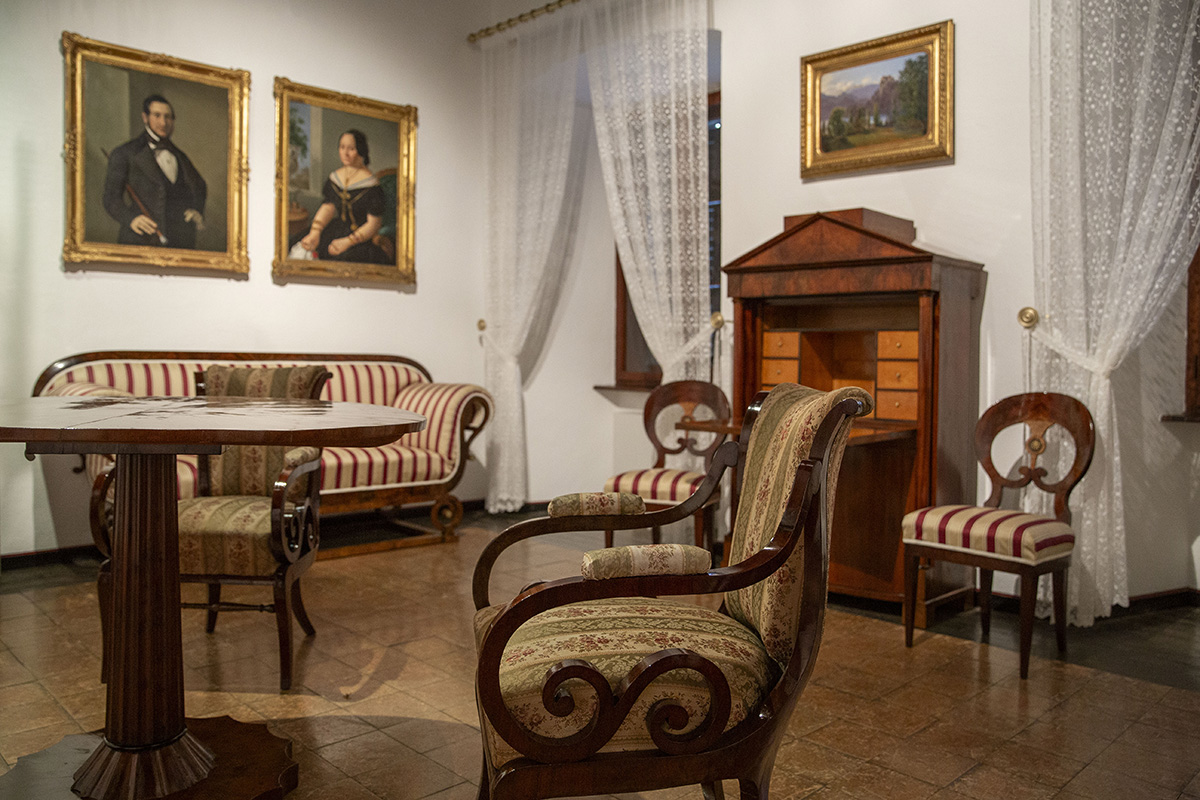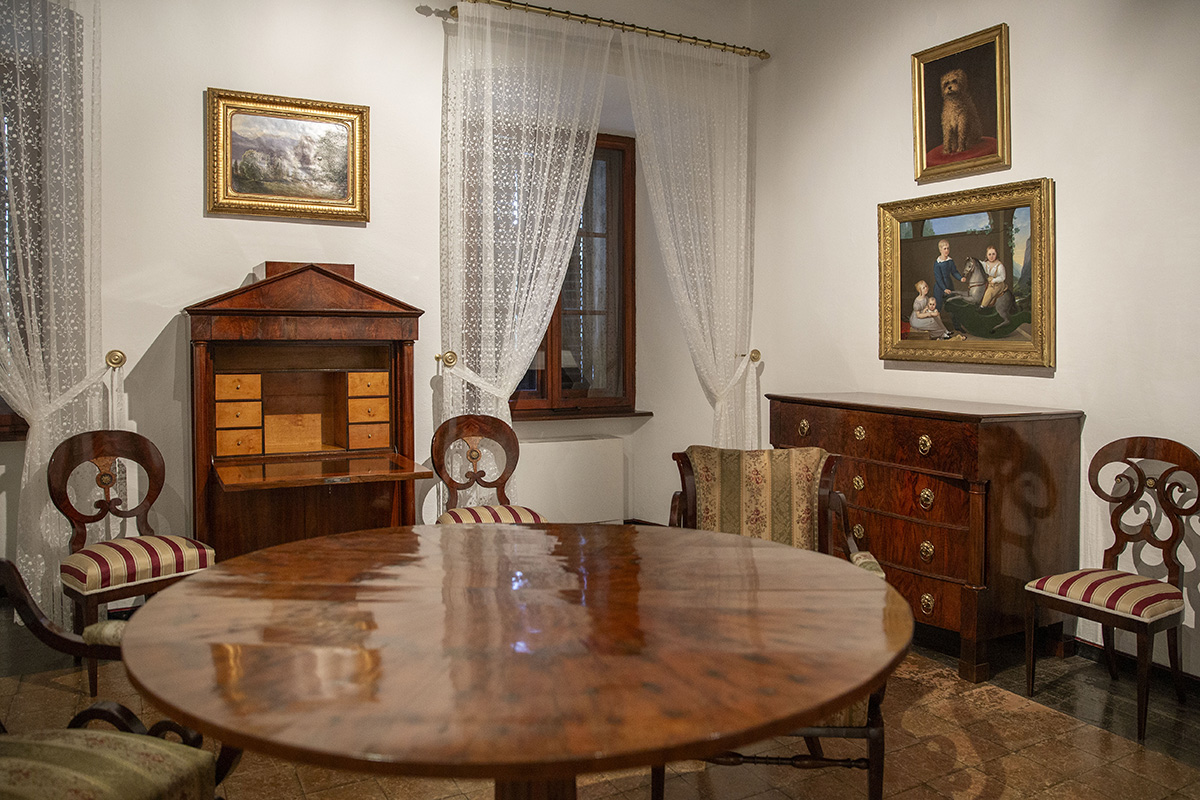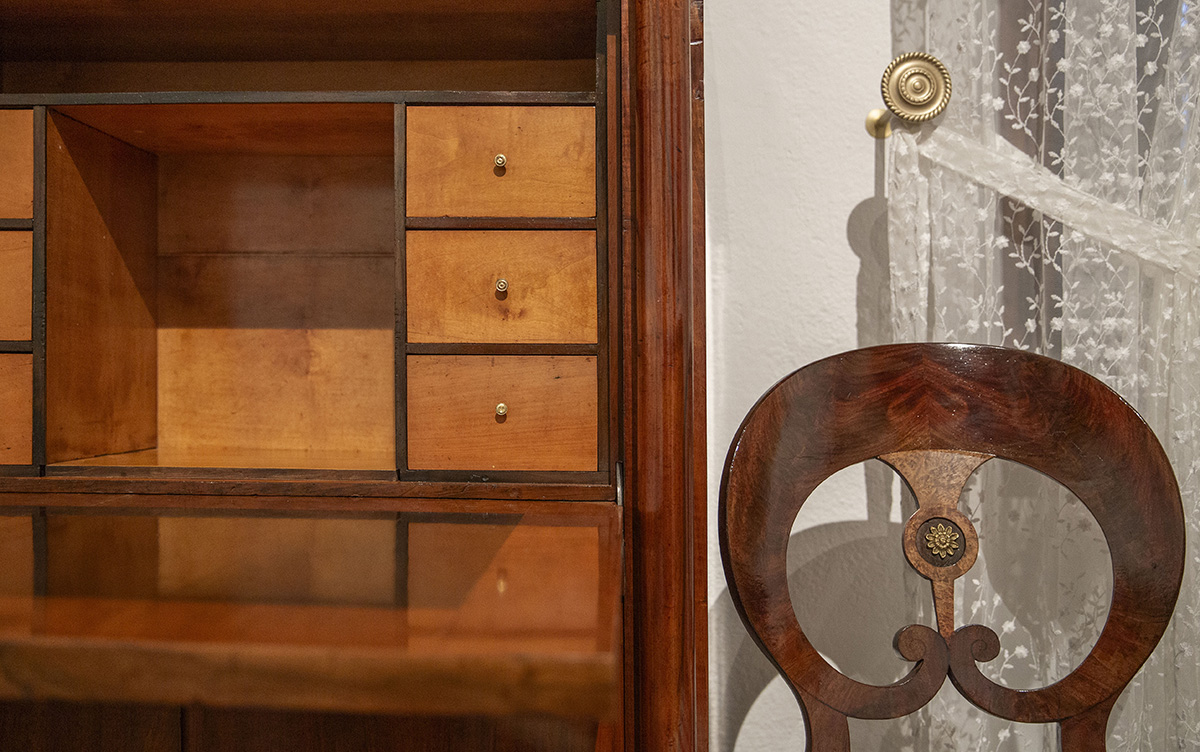
Biedermeier Living Room of the Coronini Counts
On the first floor of Kromberk Castle, a new room was opened to the public in June 2024, exhibiting a collection of Biedermeier furniture pieces. The room was brought to life through cross-border collaboration with the Palazzo Coronini Cronberg Fundation from Gorizia who has lent the restored furniture pieces to the Regional Museum Goriški muzej.
After overcoming lengthy bureaucratic procedures and obstacles to transfer furniture from Italy to Slovenia, in October 2022, we managed to transport selected pieces of furniture from Gorizia depot to the conservation and restoration workshops in Solkan, where our conservator-restorer Davorin Pogačnik spent more than a year working on the sofa, chairs, armchairs, secrétaire, chandelier, desk and chest of drawers to restore them to their original glory. The restoration was funded by the Municipality of Nova Gorica.

Curators Katarina Brešan from the Regional Museum Goriški muzej and Cristina Bragaglia from the Palazzo Coronini Cronberg Foundation, among the extensive collection of furniture of the Coronini Counts focused on the first half of the 19th century, as reflected in the reconstruction of the living space on display in the castle. Following the Congress of Vienna (which redrew European borders at the end of the Napoleonic War), the values of bourgeoisie became established on Austrian territory, and new tastes in interior decoration and decorative arts were also introduced. The term "Biedermeier", which in the middle of the 19th century became a pejorative term for the style that emerged between 1815 and 1848, is derived from the word "Bieder", which means "simple-minded", and one of the most common German surnames of the time “Meir”. The Biedermeier style which was rediscovered and revalued by the modernism at the beginning of the 20th century, actually took elements of neoclassicism and French Empire style, and is characterized by clear simplicity and elegance. It was inspired above all by the concepts of comfort, rationality and functionality, without renouncing the search for elegance in the use of materials and decorative elements. The depictions of noble dwellings of the time show that the nobility also adapted to this bourgeois taste, abandoning luxury in favour of practicality.

In the Biedermeier ambiences, furniture was characterized above all by comfort, no longer following the rules of symmetry and representativeness of previous centuries, but rather the needs and desires of those who lived in those spaces. Furniture usually took up all the available space, and in addition to fixed items, chest of drawers and secrétaires, larger and smaller tables were used, including folding tables that could be easily moved when necessary. The type of furniture that best expresses the spirit of the Biedermeier style are the richly upholsted sofas, chairs and armchairs, characterized by the search for new forms and the celebration of the natural beauty of materials. The traditional geometric shapes of the furniture are thus enlived by curved, elegant and dynamic elements; the surfaces are freed from complicated, superfluous ornaments so that the charming patterns of the veneers, which were obtained using different types of wood, can be brought to fore. The décor is elegant but never ostentatious, with curves and clear lines that transform the space in a harmonious way.
In the first half of the 19th century, he Biedermeier spread throughout Europe with large-scale sales, which reduced production costs and allowed the introduction of easily reproducible designs that suited general taste. This success was also due to the ingenuity of some craftsmen, who began to present their production in catalogues and collections of drawings. The most famous was the Möbelfabrik, founded in Vienna in 1804 by Joseph Ulrich Danhauser. Despite their simplicity, Danahauser’s creations, whose patterns can be identified in the Coronini family furniture on display, were certainly not aimed at the masses, but were only accessible to the middle and upper classes.
The living room is also decorated with paintings from the collection of the Regional Museum Goriški muzej, among which we have displayed two of the portraits that Count William Coronini gave to the museum in exchange for the two stone sculptures that now stand in the park of the Coronini Cronberg Palace in Gorizia.

In addition, the exhibitions presents the Gorizia branch of the Coronini Cronberg family, about which we have also recorded testimonies from the inhabitants of Kromberk, which will shed further light on the former owners of the castle after whom the place is named. This year marks 70 years since the castle became the headquarters of the Regional Museum Goriški muzej. During the extensive renovation works, the museum consulted Count William on several occasions regarding the architectural solutions and the layout of the park. His sister Nikoleta – this year is the 40th anniversary of her death – also placed strong attachment to Kromberk and its inhabitants.
Photo: Katarina Brešan
Location: Kromberk Castle
From:
15 Jun 2024
Till:
15 Jun 2028